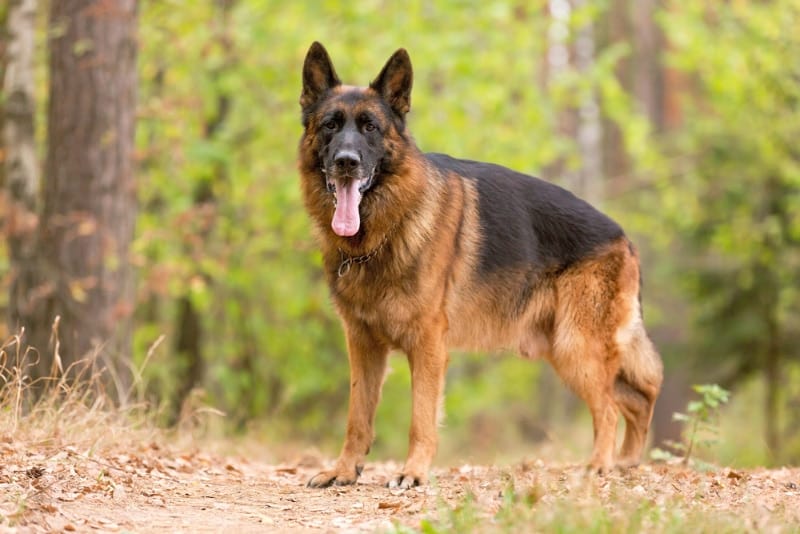
The German Shepherd is a well-balanced dog in both temperament and physical appearance.
The German Shepherd dog is more even-tempered than some of the other herding breeds. Whether you have a long haired German Shepherd or a short haired German Shepherd, these handsome dogs make an excellent family pet. It is also highly intelligent and trainable, making it a great herding and work dog. These qualities make this breed a favorite of many dog enthusiasts.
The German Shepherd, or GSD, is a highly trainable, intelligent, and loyal breed. It is generally friendly and even-tempered, though is a protective guard dog when needed. Its trainable nature makes it a great pick for a range of work or competitions. Due to its well-balanced nature and many positive qualities, it is a highly favored dog by many pet owners throughout the world.
- Kingdom: Animalia
- Phylum: Chordata
- Class: Mammalia
- Order: Carnivora
- Family: Canidae
- Genus: Canis
- Species: lupus familiaris
Common Name(s)
German Shepherd Dog, Alsation, GSD, Deutscher Schaferhund
Breed Type
This breed is a member of the herding dogs. These dogs were bred for herding cattle or sheep, which explains many of their characteristics. They are extremely active, intelligent, and driven to work. If not provided with an organized activity, such as herding trials or Flyball, these dogs are likely to find something less desirable to do, such as digging up gardens or chewing on shoes. Herding dogs are still currently used to herd livestock, but they can also be great pets for active owners with the time and energy to meet their needs.
Background
The German Shepherd was bred from a variety of shepherd dogs, including long-haired, short-haired, and wire-haired types, in the 1890’s by a group of dog enthusiasts in Germany called the Phylanx Society. However, the group did not last long enough to establish the German Shepherd as a new breed. Rather, it was Captain Max von Stephanitz who recognized the valuable qualities of the breed and formed the first German Shepherd Society (Verein fur deutsche Schaferhunde) in 1899. The original dog was named Hektor Linksrhein and renamed Horand v Grafeth by von Stephanitz.
The breeding programs that ensued sought to maintain the main qualities of utility and intelligence that were present in this first specimen. These qualities have made the German Shepherd not only an excellent sheep herder, but also an exceptional police, military, guide, and search and rescue dog.
Description
The German Shepherd is a large, muscular dog, weighing 60-140 pounds and measuring 22 to 26 from paw to shoulder with females slightly smaller than males. The ears are large and stand straight up, the eyes are dark and almond-shaped, and the nose is black. The neck is long, as well as the tail, which is set low and curves slightly.
The coat can be medium or long in length, but the medium-length variety is more widely accepted by shows. The coat is generally straight, though it can be slightly wavy. Color types include black, black and tan, and sable, cream, and white, though the cream and white varieties are not accepted by many breeders and registries. This breed’s lifespan is 10-15 years.
Care and Feeding
This breed requires no special diet and moderate grooming. It sheds throughout the year, needing weekly grooming, except in the summer, when shedding is more profuse and daily brushing is appropriate.
German shepherds need regular checkups. Vaccinations are due as follows:
- 6-8 weeks: Distemper, Leptospirosis, Hepatitis, Parainfluenza, Parvo, and Corona virus (DHLPPC)
- 10-12 weeks: Second DHLPPC
- 14-16 weeks: Third DHLPPC and rabies
- Annually: DHLPPC and rabies booster
Housing Your Dog
German shepherds can adapt to city, suburban, or rural life, though they need a large area in order to accommodate their high activity level.
Social Behaviors
This German Shepherd is friendly with people it knows. It can be wary of strangers, though it warms up to them quickly. It will show aggression when it feels the need to protect someone. Its even temperament makes it a great guide dog, since that line of work requires work in the community around many people.
Handling and Training
The German Shepherd benefits from socialization and a basic training program. It responds much better to treats and affection for desirable behaviors than punishment for undesirable behaviors.
Activities
This breed needs activity for both its body and mind. Daily walks are appreciated, but it also needs some sort of mental activity, such as playing Frisbee or training for agility trials if not employed in regular work.
Breeding/Reproduction
This breed has an average litter size of 5-10 pups.
Common Health Problems
German Shepherds are at risk for hip and elbow dysplasia. Hip and elbow dysplasia, caused by looseness in the hip or elbow joint, can cause discomfort after exercise, an altered gait, and even an inability to walk. A veterinarian can diagnose and prescribe treatment for this disease, which may include weight management, exercise, massage, supplements, and surgery.
Availability
German Shepherds are readily available from breeders found locally or on the internet. Prices range from around $100 for an adult pet, $250-$600 for pet quality puppies, and $700-1500 for show or breeder quality puppies.
References
- Animal-World References: Dog Breeds
- Walter R. Fletcher, Dogs of the World, Bantam Doubleday Dell Publishing Group, 1983
- Peter Larkin, The Ultimate Encyclopedia of Dogs (Dog Breeds & Dog Care) , Lorenz Books, 2003
- Kristin Mehus-Roe, The Original Dog Bible: The Definitive Source to All Things Dog, BowTie Press, 2005
- Daniel F. Tortora, The Right Dog for You: Choosing a Breed that Matches Your Personality, Family, and Lifestyle, Fireside, 1983
- “History of the Breed”, (2008) Germanshepherds.com, http://www.germanshepherds.com/thegsd/history
Featured Image Credit: Osetrik, Shutterstock
